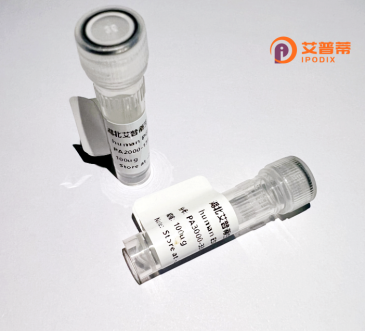
| 纯度 | >90%SDS-PAGE. |
| 种属 | Human |
| 靶点 | ERVWE1 |
| Uniprot No | Q9UQF0 |
| 内毒素 | < 0.01EU/μg |
| 表达宿主 | E.coli |
| 表达区间 | 21-443aa |
| 氨基酸序列 | APPPCRCMTSSSPYQEFLWRMQRPGNIDAPSYRSLSKGTPTFTAHTHMPRNCYHSATLCMHANTHYWTGKMINPSCPGGLGVTVCWTYFTQTGMSDGGGVQDQAREKHVKEVISQLTRVHGTSSPYKGLDLSKLHETLRTHTRLVSLFNTTLTGLHEVSAQNPTNCWICLPLNFRPYVSIPVPEQWNNFSTEINTTSVLVGPLVSNLEITHTSNLTCVKFSNTTYTTNSQCIRWVTPPTQIVCLPSGIFFVCGTSAYRCLNGSSESMCFLSFLVPPMTIYTEQDLYSYVISKPRNKRVPILPFVIGAGVLGALGTGIGGITTSTQFYYKLSQELNGDMERVADSLVTLQDQLNSLAAVVLQNRRALDLLTAERGGTCLFLGEECCYYVNQSGIVTEKVKEIRDRIQRRAEELRNTGPWGLLSQ |
| 分子量 | 49.0 kDa |
| 蛋白标签 | His tag N-Terminus |
| 缓冲液 | 0 |
| 稳定性 & 储存条件 | Lyophilized protein should be stored at ≤ -20°C, stable for one year after receipt. Reconstituted protein solution can be stored at 2-8°C for 2-7 days. Aliquots of reconstituted samples are stable at ≤ -20°C for 3 months. |
| 复溶 | Always centrifuge tubes before opening.Do not mix by vortex or pipetting. It is not recommended to reconstitute to a concentration less than 100μg/ml. Dissolve the lyophilized protein in distilled water. Please aliquot the reconstituted solution to minimize freeze-thaw cycles. |
以下是3条关于重组人ERVWE1蛋白的参考文献及其核心内容概括(基于近年研究):
---
1. **文献名称**: *The fusogenic activity of the human endogenous retrovirus envelope glycoprotein (HERV-W) requires sequential interactions with receptors*
**作者**: Cheynet V. et al. (2013)
**摘要**: 研究通过重组表达HERV-W/ERVWE1包膜糖蛋白,证明其介导细胞融合的机制依赖于与受体(ASCT2)的两步结合,并揭示其pH依赖性激活特点,为理解其在胎盘发育和病理中的作用提供结构基础。
---
2. **文献名称**: *Role of ERVWE1 in human trophoblast cell fusion: Implications for placental development*
**作者**: Vargas A. et al. (2009)
**摘要**: 通过体外实验验证重组ERVWE1蛋白在滋养层细胞合胞体形成中的关键作用,发现其通过调控细胞膜脂质重组和钙信号通路促进融合,提示该蛋白异常表达可能导致妊娠疾病。
---
3. **文献名称**: *Autoimmune response to ERVWE1 in multiple sclerosis: Molecular mimicry hypothesis*
**作者**: Mameli G. et al. (2018)
**摘要**: 利用重组ERVWE1蛋白进行免疫印迹实验,发现多发性硬化症患者血清中特异性抗体水平升高,推测病毒表位与中枢神经蛋白存在分子拟态,可能参与自身免疫发病机制。
---
**提示**: 更多前沿研究可关注 **《Retrovirology》** 和 **《Placenta》** 期刊,近年多聚焦于ERVWE1在神经退行性疾病及肿瘤免疫微环境中的作用(如2023年Li等关于胶质母细胞瘤的研究)。建议使用PubMed的MeSH词“Endogenous Retroviruses”和“Syncytins”筛选高质量文献。
The human endogenous retrovirus group W member 1 (ERVWE1) gene, located on chromosome 7q21.2. is a relic of ancestral retroviral integration into the human genome. It encodes Syncytin-1. a fusogenic envelope glycoprotein critical for placental development. Syncytin-1 mediates trophoblast cell fusion, enabling the formation of the multinucleated syncytiotrophoblast layer essential for fetomaternal exchange, immune tolerance, and hormonal secretion during pregnancy. Unlike its ancestral viral role, ERVWE1-derived Syncytin-1 has been co-opted by host evolution for reproductive functions.
Recombinant ERVWE1 protein, produced via molecular cloning and heterologous expression systems (e.g., mammalian or bacterial cells), retains fusogenic activity and structural features like surface unit (SU) and transmembrane (TM) domains. It serves as a vital tool to study Syncytin-1’s role in cell-cell fusion mechanisms, placental pathophysiology (e.g., preeclampsia linked to reduced expression), and its dual role in health and disease. Notably, ERVWE1 dysregulation is implicated in autoimmune disorders (e.g., multiple sclerosis) and cancers, possibly due to aberrant membrane fusion or immune modulation.
Research on recombinant ERVWE1 protein also explores its therapeutic potential, including targeted drug delivery systems leveraging its fusogenic properties. However, ethical and technical challenges persist, particularly in distinguishing endogenous physiological roles from pathological activation. This protein remains a focal point for understanding human development, retroelement co-option, and disease pathways.
×